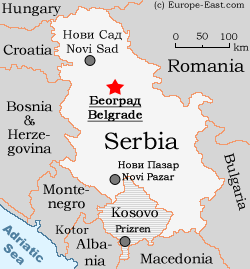Official name
????????? ?????? (Republika Srbija) - the official name is Republic of Serbia. Serbia is by some people still associated with Југославија (Yugoslavia). Serbia includes two autonomous districts: The Kosovo in the south, which is under UN administration by now, and the Vojvodina in the north of Serbia. However, the autonomous status of the Vojvodina was abolished some years ago. This website is exclusively about the Republika Srbija - the Serbian Republic - which should not be confused with Republika Srpska (one of the two entities in →Bosnia-Hercegovina). Note that information about Montenegro is on a different page: →Montenegro.
Area & Population

| ||
| Clickable Map of Serbia |
Serbia covers an area of 88,361 km² (same as Scotland).
The population is around 9.4 million* (2003). Serbia without the Kosovo has around 7.5 million people (official figure).
The population of Serbia is rather mixed. Official figures for Serbia excl. the →Kosovo are as followed: Serbians: 83%, Hungarians: 4%, Bosniaks: 2%. The rest (more than 10%) are Montenegrins, Roma, Croatians, Slovenians, Albanians, Romanians etc. (according to a census in 2002).
Religion
65% are Serbian-Orthodox, 19% Moslems (mainly in the Kosovo), 4% Roman-Catholic, 1% Protestants, 11% others
Time zone
GMT +01 hr (Central Europe Time), with daylight-saving time (+1 hour) in summer.
Serbian. Until the 1990ies, the language was referred to as Serbo-Croatian, but now it's regarded as a single language. In contradiction to →Croatian, the Cyrillic script is used in Serbia and Montenegro. Serbian as well as Croatian belong to the South Slavic language group. Serbian is also used in wide parts of →Bosnia. Serbian and Croatian are indeed quite familiar, but there are characteristic differences in vocabulary, pronunciation and partially even in grammar. To give an example, a long Serbian [e] is often pronounced [ije] (pron: iye) in Croatian. Hence, the Serbian word [ reka ] (=river) becomes [ rijeka ] in Croatian. On the other hand, a short Serbian [ e ] is sometimes pronounced [ je ] in Croatian. Serbian uses most of the Cyrillic letters you will also find in Russian, but there are several exceptions:
- Ђ ( ђ ) Close to [ dsh ] (phon: ɟ ), read as the [ du ] in [ education ] (but softer). In Latin script, this letter is written Đ ( đ ).
- J ( j ) Not very commmon in Slavic alphabets. Pronounced as the [ y ] (phon: j) in [ yes ].
- Љ ( љ ) A mixture of 'L' and the 'soft sign', pronounced as the [ li ] (phon: lj) in [ million ].
- Њ ( њ ) A mixture of 'N' and the 'soft sign', spoken as the [ ny/ñ ] (phon: nj) in [ cañon/canyon ].
- Ћ ( ћ ) is close to the [ tch ] (phon: ɕ ) in [ kitchen]. In Latin script this letter is written Ć ( ć ).
Because of these 'special' characters, some other typical Cyrillic letters are not used in Serbian and/or substituted by other letters, as there are я → ja (ya), ю → jy (yu), щ (shtch, not existent), ъ (hard sign, not used) and ь → ђ, њ, љ. A basic knowledge of Russian for example is very helpful, although some important words are completely different: 'Thank you' for example is [ спасибо = spasibo ] in Russian, [ благодарам = blagodaram ] in Macedonian but [ хвала = hvala ] in Serbian.
For a table with the most important words in Macedonian and other Slavic languages please →click here.. Anyway, it's not so problematic to get by in English and even in German (chances are higher to meet someone speaking the latter).
Serbia wrote:
Before Second World War, Serbian used only cyrilic. After WW2, comunists was introduced latin letters to Serbian in order to decrease difference between Serbia and Croatia and today latin letters are dominant in Serbia, esspecially in the north of Serbia.
Posted by Serbia on December 24, 2009 02:57
©2024 Europe-East.com

 Albania
Albania Serbia
Serbia